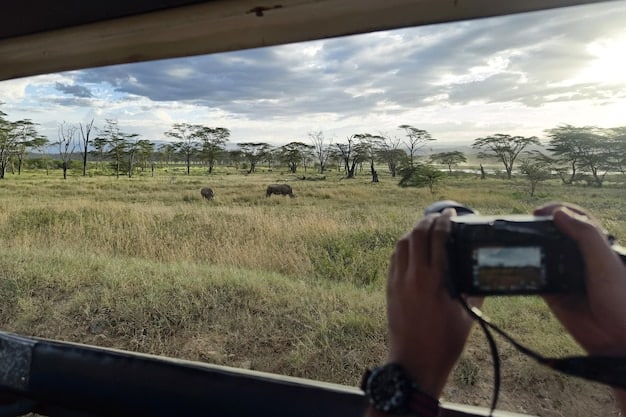Ethical Wildlife Tourism: Observe Animals Responsibly

Engaging in ethical wildlife tourism means observing animals responsibly and actively supporting conservation efforts, ensuring unique travel experiences contribute positively to biodiversity and local communities.
Embarking on a journey to witness wildlife in its natural habitat is a profound privilege. However, for a truly meaningful and impactful experience, it’s essential to understand and practice ethical wildlife tourism: learn how to observe animals responsibly and support conservation efforts. This approach transforms a simple trip into an act of preservation, benefiting both a traveler’s understanding and the delicate ecosystems they visit.
The Essence of Ethical Wildlife Tourism
Ethical wildlife tourism is more than just avoiding harm; it’s about actively contributing to the well-being of animals and their environments. It involves a conscious choice to engage with nature in a way that respects the autonomy and natural behavior of wild creatures, while also fostering sustainable practices that benefit local communities and conservation initiatives. Understanding this core principle is the first step toward responsible travel.
At its heart, ethical wildlife tourism seeks to minimize human impact on wildlife and ecosystems. This means recognizing that our presence, no matter how well-intentioned, can disrupt natural processes if not managed carefully. From avoiding direct interaction to supporting reputable operators, every decision made as a traveler can have significant repercussions, positive or negative.
Minimizing Disturbance: A Core Principle
The primary goal when observing wildlife is to do so without causing stress or altering natural behaviors. This requires patience, respect, and a deep understanding of animal ecology. Loud noises, sudden movements, or approaching too closely can cause animals to flee, abandon nests, or become habituated to human presence, which can lead to dangerous situations for both animals and humans.
- Maintain a safe and respectful distance from all wildlife.
- Avoid sudden movements or loud noises that could startle animals.
- Never feed wild animals, as it alters their natural foraging behaviors and can make them dependent.
- Do not entice animals with food for a closer photo opportunity.
Furthermore, understanding the specific needs of different species is crucial. What might be acceptable for observing a herd of giraffes from a distance might be entirely inappropriate for nesting seabirds or nocturnal predators. Responsible tour operators and guides play a vital role in educating travelers on these nuances, ensuring that observations are discreet and non-intrusive. The goal is to be an unobtrusive observer, a silent witness to nature’s incredible drama.
Supporting Genuine Conservation
Another fundamental pillar of ethical wildlife tourism is the active support of genuine conservation efforts. This goes beyond simply visiting a park; it involves channeling tourism dollars directly into programs that protect habitats, combat poaching, and alleviate human-wildlife conflict. Many organizations rely heavily on tourism revenue to fund their vital work, making informed traveler choices incredibly powerful.
When selecting a tour operator, look for those with transparent policies on how their profits contribute to conservation. They should be able to articulate specific projects or initiatives they support, such as anti-poaching units, habitat restoration, community development programs, or wildlife rehabilitation centers. True ethical tourism integrates these efforts seamlessly into its business model, rather than treating them as an afterthought.
In essence, ethical wildlife tourism transforms the traveler from a mere spectator into an active participant in conservation. It’s about recognizing the interconnectedness of all living things and the profound responsibility we bear when stepping into their world. By adhering to these principles, we can ensure that our desire to experience wildlife contributes to its long-term survival, creating a legacy of respect and preservation for future generations.
Choosing the Right Tour Operator
Selecting an ethical tour operator is perhaps the most critical decision a traveler can make when planning a wildlife encounter. The industry is vast and not all companies prioritize animal welfare or conservation equally. A discerning approach in your research can make the difference between a harmful experience and a genuinely beneficial one for both wildlife and local communities.
Begin by researching potential operators thoroughly. Look for companies that are transparent about their animal welfare policies and their contributions to local conservation. Websites are a good starting point, but don’t hesitate to contact them directly with questions. Reputable operators will be eager to provide details and evidence of their ethical practices.
Key Indicators of an Ethical Operator
There are several tell-tale signs that an operator is committed to ethical practices. One of the most important is their accreditation or affiliation with recognized conservation bodies and industry associations that promote responsible tourism. These affiliations often imply adherence to certain standards and codes of conduct.
- Small Group Sizes: This minimizes disturbance to animals and allows for more personalized, respectful observation.
- Experienced and Knowledgeable Guides: Guides should be local experts, well-versed in animal behavior, conservation issues, and local culture. They should prioritize animal welfare over photo opportunities.
- No Direct Animal Interaction (unless genuinely beneficial for rehabilitation): Avoid operators offering elephant riding, tiger petting, or swimming with captive dolphins, as these activities often involve animal cruelty and exploitation.
- Clear Distance Protocols: Operators should maintain strict, respectful distances from wildlife, using binoculars or zoom lenses for viewing, not intrusive proximity.
- Support for Local Communities: Ethical operators often employ local staff, source goods and services locally, and contribute directly to community development projects.
- Waste Management and Environmental Impact: They should have clear policies for minimizing waste, using sustainable transport, and reducing their carbon footprint.
Furthermore, pay attention to the language used by the operator in their marketing materials. Do they emphasize “up close and personal” encounters, or do they focus on “observing without disturbing” and “immersing in nature”? The latter often indicates a more responsible approach. Personal recommendations from trusted sources and reviews on independent travel forums can also provide valuable insights into an operator’s real-world practices.
Asking the Right Questions
When in doubt, empower yourself by asking specific questions before booking. Inquire about their emergency protocols for wildlife, their guides’ training, and how they handle situations where tourists might try to approach animals too closely. A good operator will welcome these questions and respond with confidence and clarity, demonstrating their commitment to ethical standards.
Consider asking about the destination itself. Are they operating in protected areas with strict regulations? Do they contribute to the maintenance or expansion of these protected zones? An ethical operator will not only adhere to existing rules but will also actively advocate for stronger conservation policies and support community-led conservation initiatives in the areas where they operate. Your thorough research is an investment in the future of wildlife.

Responsible Observation: Best Practices in the Field
Once you’ve chosen an ethical operator and embarked on your journey, your actions in the field become paramount. Responsible observation is about prioritizing the well-being of the animals above your own desire for the perfect photograph or close encounter. It requires discipline, patience, and a willingness to simply witness nature unfolding on its own terms.
The golden rule is “leave no trace, take nothing but photographs, kill nothing but time.” This mantra extends to minimizing your presence and impact. Think of yourself as a guest in a wild home, acting with the utmost respect and courtesy. This includes not just your physical actions, but also your acoustic and visual footprint.
Maintaining Distance and Silence
The most crucial aspect of responsible observation is maintaining an appropriate distance from wildlife. What constitutes “appropriate” varies by species and situation, but generally, if an animal changes its behavior because of your presence, you are too close. Guides from reputable operators will enforce these distances, often using binoculars or telephoto lenses to enhance your viewing experience from afar.
- Always stay in your vehicle or designated viewing areas when observing large or potentially dangerous animals.
- Avoid making sudden movements or loud noises that could startle animals or disrupt their natural behaviors.
- Keep voices low and avoid shouting or yelling.
- Turn off flash photography, particularly at night or in low-light conditions, as it can disorient or frighten animals.
Silence allows animals to continue their normal routines, from foraging and hunting to mating and raising young. It also enhances your own experience, allowing you to hear the subtle sounds of the wilderness and truly immerse yourself in the natural environment. Patience is key; sometimes the most rewarding sightings come after long periods of quiet observation.
Avoid any form of feeding or baiting. Animals can quickly become habituated to human food, leading to aggressive behavior, nutritional deficiencies, and increased vulnerability to disease or predators. Feeding also disrupts natural foraging patterns and can lead to dangerous encounters, both for the animals and for humans.
Respecting Natural Habitats and Pathways
Responsible observation extends to the wider environment. Stick to designated trails and pathways to avoid trampling delicate vegetation or disturbing nesting sites. This is especially important in sensitive ecosystems like wetlands, forests, and remote wilderness areas. Off-roading, unless on a designated safari track with a professional guide, can cause irreparable damage to fragile habitats.
Never take souvenirs from natural environments, such as rocks, plants, or animal remains. These are integral parts of the ecosystem and their removal can have unforeseen consequences. The beauty of the wild lies in its untouched state, and our role is to preserve that integrity for future generations and for the wildlife that calls it home.
Understanding Animal Welfare & Exploitation
Distinguishing between ethical wildlife encounters and exploitative practices is crucial for any responsible traveler. Unfortunately, not all animal-related tourism activities prioritize the well-being of the creatures involved. Many seemingly innocent interactions can hide a dark reality of animal cruelty, suffering, and species exploitation. Education is your best defense against inadvertently supporting these harmful practices.
The key principle to remember is that genuine ethical wildlife tourism focuses on observation from a distance, allowing animals to exist naturally in their own environment. Any activity that forces an animal into unnatural behaviors for human entertainment or profit should raise a major red flag.
Cruel Practices to Avoid
Certain activities are widely recognized as inherently unethical due to the inherent cruelty and exploitation involved. These include:
- Elephant Riding: The process of “breaking” young elephants for riding involves severe physical and psychological torture, known as “phajaan” or “crushing the spirit.”
- Tiger/Lion Petting or Walking: Big cats used for these activities are often declawed, drugged, and kept in confined spaces, denying them their natural instincts and behaviors.
- Dolphin/Whale Swim-with Programs (in captivity): Captive marine mammals often suffer from stress, illness, and shortened lifespans due to confinement and forced interaction.
- Snake Charming/Bear Dancing: These acts involve horrific training methods that inflict pain and fear, making animals perform unnatural tricks.
- Monkey Shows: Monkeys used in shows are often trained using cruel methods, kept in isolation, and are not able to express natural behaviors.
These activities are not about conservation or genuine appreciation; they are about human entertainment at the expense of animal welfare. They often contribute to the illegal wildlife trade, remove animals from the wild, or perpetuate cycles of abuse in captivity. Your decision not to participate sends a clear message to these industries.
The Problem with “Sanctuaries” and “Orphanages”
Even facilities marketed as “sanctuaries” or “orphanages” require careful scrutiny. While some are legitimate and perform vital rescue and rehabilitation work, others are fronts for animal breeding, trading, or exploitative tourism. A truly ethical sanctuary prioritizes the animals’ welfare above all else. This means limited human interaction, large natural enclosures, and a focus on rehabilitation and eventual release back into the wild if possible.
Beware of places that allow direct physical contact with wild animals, especially cubs or young animals, unless under strict veterinary supervision for rehabilitation. Also, question any facility that continuously breeds animals or has a suspiciously high number of “orphans.” A genuine sanctuary will prioritize the animal’s needs over tourist interaction, making it a place where observation, not interaction, is key.
By understanding these distinctions, you become an informed consumer, capable of making choices that genuinely support animal welfare and conservation, rather than inadvertently fueling exploitative industries. Your ethical choices contribute directly to a world where wild animals can thrive in their natural habitats, free from exploitation.
Supporting Local Communities and Economies
Ethical wildlife tourism isn’t just about protecting animals and their habitats; it’s also deeply intertwined with supporting the human communities that coexist with wildlife. When tourism benefits local people, it creates a powerful incentive for them to protect the very wildlife that attracts visitors. This reciprocal relationship is fundamental to sustainable conservation.
Economic empowerment of local communities through tourism can reduce reliance on practices that might otherwise harm wildlife, such as poaching or unsustainable resource extraction. When locals see direct benefits from conservation, they become active partners in safeguarding their natural heritage.
Direct Economic Contributions
One of the most direct ways for ethical tourism to benefit local communities is through employment. By choosing tour operators that primarily employ local guides, drivers, and lodge staff, you ensure that tourism revenue circulates within the local economy. This creates jobs, reduces poverty, and fosters a sense of ownership over conservation efforts.
- Hire Local Guides: They possess invaluable knowledge of the area, its wildlife, and local culture.
- Stay in Locally-Owned Accommodations: Funds go directly to the community rather than large international chains.
- Purchase Local Goods and Services: Support local artisans, restaurants, and shops.
- Visit Community-Run Projects: Some communities have established their own conservation or tourism initiatives; support them directly.
Beyond direct employment, ethical tourism can spur the development of small businesses, from craft markets to guesthouses, providing diversified income streams for residents. This economic stability makes communities more resilient and less vulnerable to pressures that might lead to resource exploitation.
Cultural Exchange and Respect
Ethical tourism also fosters meaningful cultural exchange. Engaging with local people, learning about their traditions, and respecting their way of life enriches your travel experience and builds bridges of understanding. This interaction should always be respectful, avoiding any behavior that could be perceived as intrusive or culturally insensitive.
Seek opportunities to learn about traditional conservation practices that have sustained ecosystems for centuries. Many indigenous communities possess deep ecological knowledge that can inform modern conservation strategies. Your respectful engagement acknowledges their wisdom and values their contributions.
Ultimately, supporting local communities through ethical tourism is an investment in long-term conservation. When people benefit directly from the presence of wildlife, they become its most ardent protectors, creating a sustainable future where both humans and animals can thrive side by side.

Education and Advocacy: Your Role as a Traveler
The journey of an ethical wildlife tourist doesn’t end when you return home. Your experiences can be powerful tools for education and advocacy, inspiring others to travel responsibly and supporting broader conservation efforts. By sharing your insights and advocating for ethical practices, you amplify the positive impact of your travels.
Your unique perspective, gained from firsthand observation, can help shape public opinion and influence policy. Whether through informal conversations or more organized advocacy, every voice contributes to raising awareness and promoting a more sustainable approach to tourism.
Sharing Experiences Responsibly
When sharing your wildlife encounters on social media or with friends and family, be mindful of the message you convey. Emphasize the importance of maintaining distance, respecting natural habitats, and supporting ethical operators. Instead of focusing solely on the “pretty picture,” highlight the responsible way in which the encounter occurred.
- Use educational captions: Explain how your presence did not disturb the animals.
- Acknowledge ethical operators: Tag or mention the companies that uphold high standards.
- Debunk myths: Correct misconceptions about harmful practices like animal petting or riding.
- Promote conservation messages: Share facts about the species you saw and the threats they face.
Avoid posting images or videos that depict irresponsible behavior, even if it wasn’t your own. This includes images of people too close to animals, feeding wildlife, or otherwise disturbing their natural state. By curating your social media presence to reflect ethical practices, you set an example for others to follow.
Supporting Conservation Beyond Travel
Your advocacy doesn’t have to be limited to sharing travel stories. Consider supporting reputable conservation organizations directly, either through donations, volunteering, or participating in their campaigns. Many organizations rely on public support to fund their vital work in protecting species and habitats globally.
Stay informed about conservation issues and policy changes. Write to your elected officials, sign petitions, and participate in local or global initiatives that address wildlife protection, climate change, and habitat loss. Your engagement, no matter how small, adds to the collective effort to safeguard our planet’s biodiversity.
By becoming an informed advocate, you transform your personal experience into a force for positive change. Ethical wildlife tourism is a continuous learning process, and by educating yourself and others, you become a vital part of the global movement towards a more sustainable and respectful relationship with the natural world.
The Future of Ethical Wildlife Tourism
The landscape of ethical wildlife tourism is continually evolving, driven by increased awareness, scientific research, and technological advancements. As travelers become more discerning and global conservation challenges intensify, the industry is poised for significant shifts toward even greater responsibility and sustainability. Understanding these trends can help shape your future travel choices and contributions.
Technological innovations, such as advanced long-range monitoring equipment and non-invasive tracking devices, are enabling better wildlife viewing experiences from a distance while minimizing disturbance. Virtual reality and augmented reality may also offer ways for people to experience wildlife without physical presence, though the thrill of real-life observation will always remain unique.
Emerging Trends and Advancements
One key trend is the growing emphasis on citizen science and participatory conservation programs. Travelers are increasingly seeking opportunities to actively contribute to research, data collection, or community-based conservation projects during their trips. This transforms tourism into a more engaging and impactful endeavor, moving beyond passive observation to active contribution.
- Citizen Science Integration: Travelers participating in data collection (e.g., photo identification of animals, bird counts).
- Restoration Tourism: Trips focused on reforestation, coral reef restoration, or habitat rehabilitation.
- Local Leadership and Ownership: More tourism initiatives being developed and managed directly by indigenous communities.
- Technology for Observation: Use of drones (with strict ethical guidelines), remote cameras, and advanced optics for viewing.
- Certification and Standards: Development of more robust and globally recognized ethical tourism certifications.
There’s also a rising understanding of the importance of holistic conservation, which integrates ecological protection with social and economic development. Future ethical tourism will likely focus even more on creating direct, tangible benefits for local communities, ensuring that conservation is economically viable and socially equitable.
Challenges and Opportunities
Despite progress, challenges remain. The rise of “greenwashing” – companies falsely claiming ethical practices – requires constant vigilance from travelers. Ensuring that tourism growth doesn’t overwhelm fragile ecosystems or displace local communities will also be critical. Furthermore, adapting to climate change impacts on wildlife and habitats will require innovative approaches from the tourism sector.
However, these challenges also present opportunities. The growing demand for meaningful, responsible travel experiences means that ethical operators have a strong market. Collaborative efforts between conservation organizations, governments, and the tourism industry can drive systemic change. By continuing to choose and advocate for ethical wildlife tourism, you are not just embarking on a personal adventure; you are contributing to a global movement that values conservation, sustainability, and the intrinsic worth of all living beings. The future of wildlife depends on conscious choices made today, starting with how we observe and appreciate the incredible natural world.
| Key Principle | Brief Description |
|---|---|
| 🚫 Minimal Disturbance | Observe from a distance, avoid noise, and never feed or interact with wild animals. |
| ✅ Ethical Operator Choice | Select operators with strong conservation policies, small groups, and no direct animal interaction. |
| 🤝 Community Support | Direct your spending to locally owned businesses and projects that benefit conservation. |
| 📢 Advocate & Educate | Share responsible travel practices and support conservation efforts beyond your trip. |
Frequently Asked Questions
▼
Ethical wildlife tourism involves observing animals responsibly in their natural habitats, without causing disturbance, while actively supporting conservation efforts and local communities. It prioritizes the welfare of the animals and the sustainability of their environments over human entertainment.
▼
Look for operators with transparent policies on animal welfare and conservation, small group sizes, experienced local guides, and no direct animal interaction. They should actively contribute to local communities and environmental initiatives, and avoid activities like elephant riding or tiger petting.
▼
Feeding wild animals disrupts their natural foraging behaviors, leading to dependence on humans, potential aggression, and nutritional deficiencies. It can also increase their vulnerability to disease and predators, ultimately harming their long-term survival in the wild.
▼
Ethical tourism supports local communities by creating jobs for guides and staff, empowering local businesses, and directing revenue to community-led conservation and development projects. This economic benefit incentivizes local people to protect wildlife as a valuable resource.
▼
“Greenwashing” refers to practices where companies misleadingly market themselves as environmentally friendly or ethical without genuinely adhering to sustainable or responsible principles. Travelers should be vigilant, researching claims thoroughly and looking for independent certifications to avoid supporting such deceptive operations.
Conclusion
Engaging in ethical wildlife tourism is an enriching experience that transcends mere observation; it’s a commitment to responsible interaction with the natural world. By choosing ethical operators, practicing respectful observation, understanding animal welfare, and actively supporting local communities, travelers become vital partners in conservation efforts. Your thoughtful choices ensure that the wonder of wildlife endures for future generations, fostering a profound connection between humanity and the wild. This conscientious approach guarantees that every encounter leaves a positive impact, making your journey both memorable and meaningful in the grand scheme of global biodiversity preservation.





